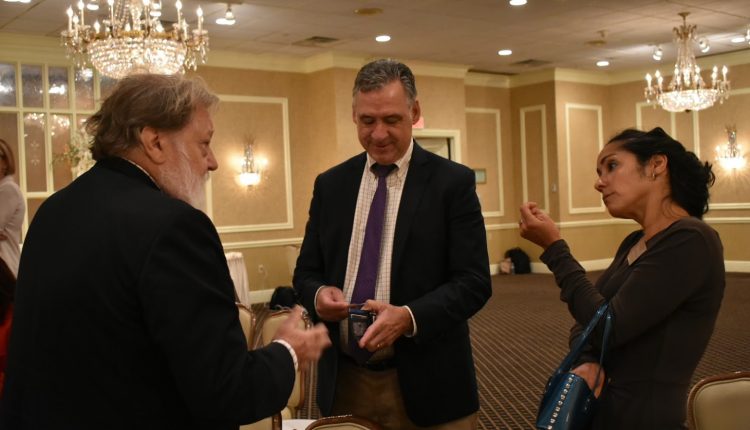
“Shark Tank” – The Government Version
By Christine Myers, Region 2 Advocate
Hundreds of entrepreneurs with pretty quirky ideas have grown their companies and their pocketbooks by appearing on the famed reality TV show, “Shark Tank.” As a contestant, you have to run the gauntlet of questions from Barbara Corcoran, Mark Cuban, and Laurie Greiner, know your numbers, appear savvy yet charming; smart but not arrogant and be ready to defend your product and make a deal. What if your product is not a special assortment of “hair ties for guys”, or a fork that doesn’t touch the table, or my favorite, a combo briefcase/electric scooter? What if your product could provide real shelter to those displaced by hurricanes, floods and fires? Instead of blue tarps that leave displaced families exposed to the elements, people could be comfortable in an easy to assemble rigid structure that even provides its own lighting and a window. Where does one go with that idea? Now granted, it isn’t a hair cutting template to help you cut your own hair, but if your house just got blown away, you are probably not thinking about how your hair looks.
During last week’s roundtable in Poughkeepsie, New York two innovative companies arrived to share their stories about their numerous efforts to convince the federal and state government to take advantage of their products. Both Tom Noonan and Gerhard Hutter have created products with, well, gravitas.
Gerhard Hutter is the inventor of the RescUshelter described above. The shelter houses up to four people, assembles in 5-10 minutes, and does not require any tools. Hutter has succeeded in getting the RescUshelter on the GSA schedule and last year received a call from FEMA after a storm, asking for 100,000 units to be delivered immediately. What’s the problem? Hutter’s company is a small business, and cannot afford to build an inventory of 100,000 without a contract. Because he could not deliver the shelters immediately, FEMA used the blue tarps.
We know disasters will happen. We see them almost constantly on the news. So doesn’t it seem reasonable that the federal government should prepare for the inevitable displacement of people, in advance of a storm? According to FEMA, the answer is no. They cannot budget for next year’s disaster. Is that possible? Do they depend on just in time ordering? When a hurricane hits, that’s when they think about procuring water, supplies and tarps?
Hutter’s solution could improve the lives of thousands if only the government would modify its procurement regulations that are reasonable for small businesses.
Tom Noonan’s More Park solution arrived in Poughkeepsie with an amazing video of a tsunami ripping through his double level parking structure. The video showed raging water slamming into the structure causing cars to hit the columns before floating away. Amazingly, the structure stood still, it didn’t move, it did not collapse, nor was it damaged. The More Park system has been used in 250 locations in Europe and Asia but has only been installed at Fort Meade here in the US. Noonan says he is having trouble getting the federal, state and local governments to consider his product. He told us that everyone “wants to be my second customer”. Don’t the 250 installations around the world and the one domestic federal installation count?
With an eight year waiting list for parking in New York City, just think of the windfall the parking lot owners could receive? Even better is the price tag: $13,500.00 and it takes fewer than 8 weeks to install.
Small companies have the ability to innovate, invent, take risks and create without constraints of corporate policies and politics. Plus small businesses are creating seven out of every ten net new jobs. The United States is the innovation nation, isn’t it?
Then how do we get the federal government to take advantage of innovative, cost saving, life-saving products like Park More and RescUShelter that could help the very people the federal government is supposed to be serving?
Perhaps we need to modify the metrics for success of the regulatory agencies: balance protectionism with opportunity, process with outcomes, and let the American people benefit from the creativity of its best small business innovators.
Back to Shark Tank – Who wouldn’t tune in to see the collective minds of Linda McMahon, General Kelly, and Dr. Ben Carson interacting with other real thought leaders an innovators? Now that is a show worth watching.
Advocacy was in New Jersey, Pennsylvania, and New York for Regional Regulatory Reform Roundtables September 11-13.
Can’t get to a roundtable near you? Fill out this form and tell us about your federal regulatory burdens. We will pass this information on to the appropriate agency and use it in the planning of upcoming Regional Regulatory Reform Roundtables.
For more information on Advocacy’s mission, our regulatory reform efforts or to find out where the next Regional Regulatory Reform Roundtables will be held, please visit: https://advocacy.sba.gov/regulation/regulatory-reform/.
Christine Myers serves as the Region 2 Advocate for the SBA Office of Advocacy, representing small businesses in New York, New Jersey, Puerto Rico, and the U.S. Virgin Islands. Myers works with small business owners, state and local governments, and small business associations to bring the voice of Region 2 to Washington DC. She can be reached at Christine.myers@sba.gov.
